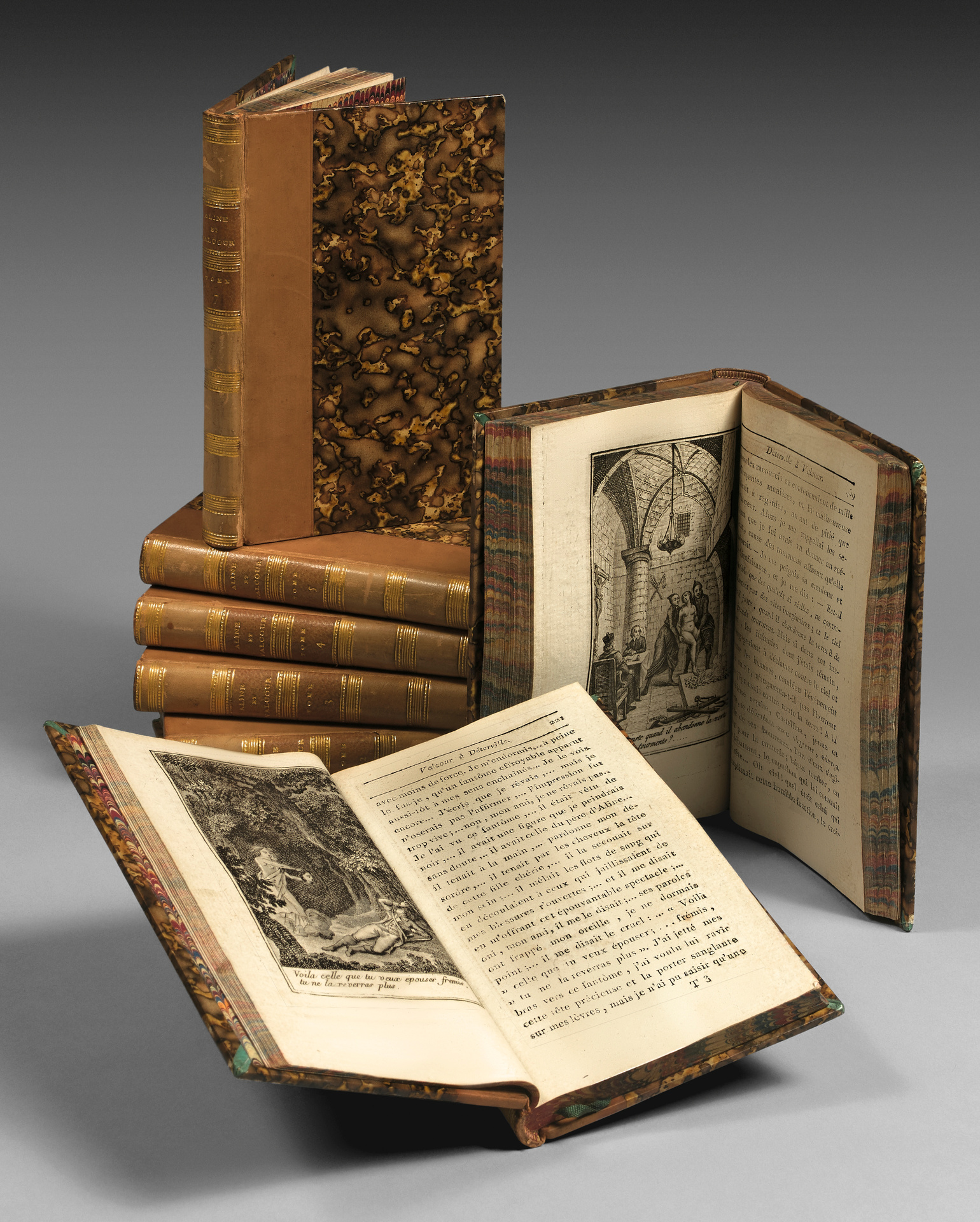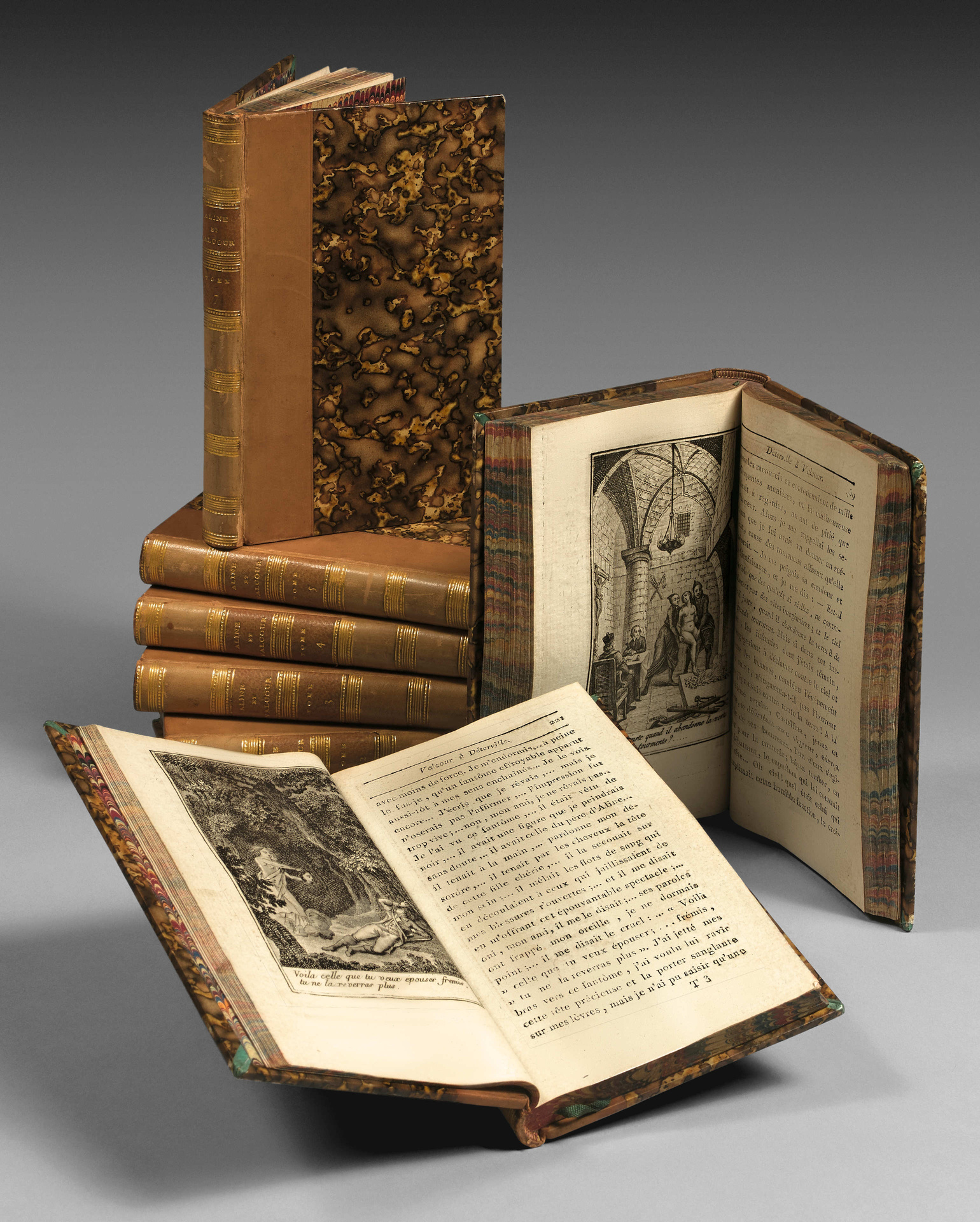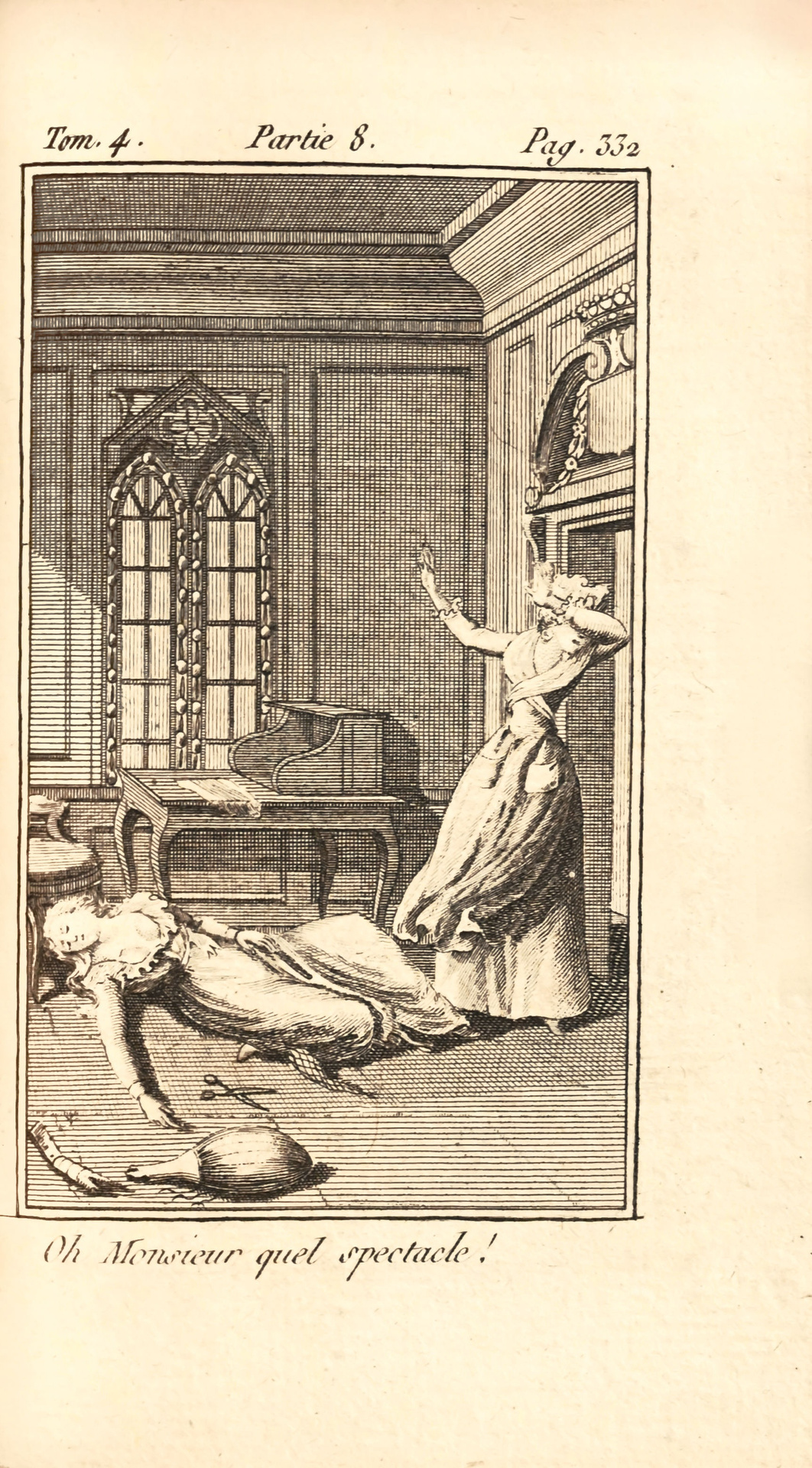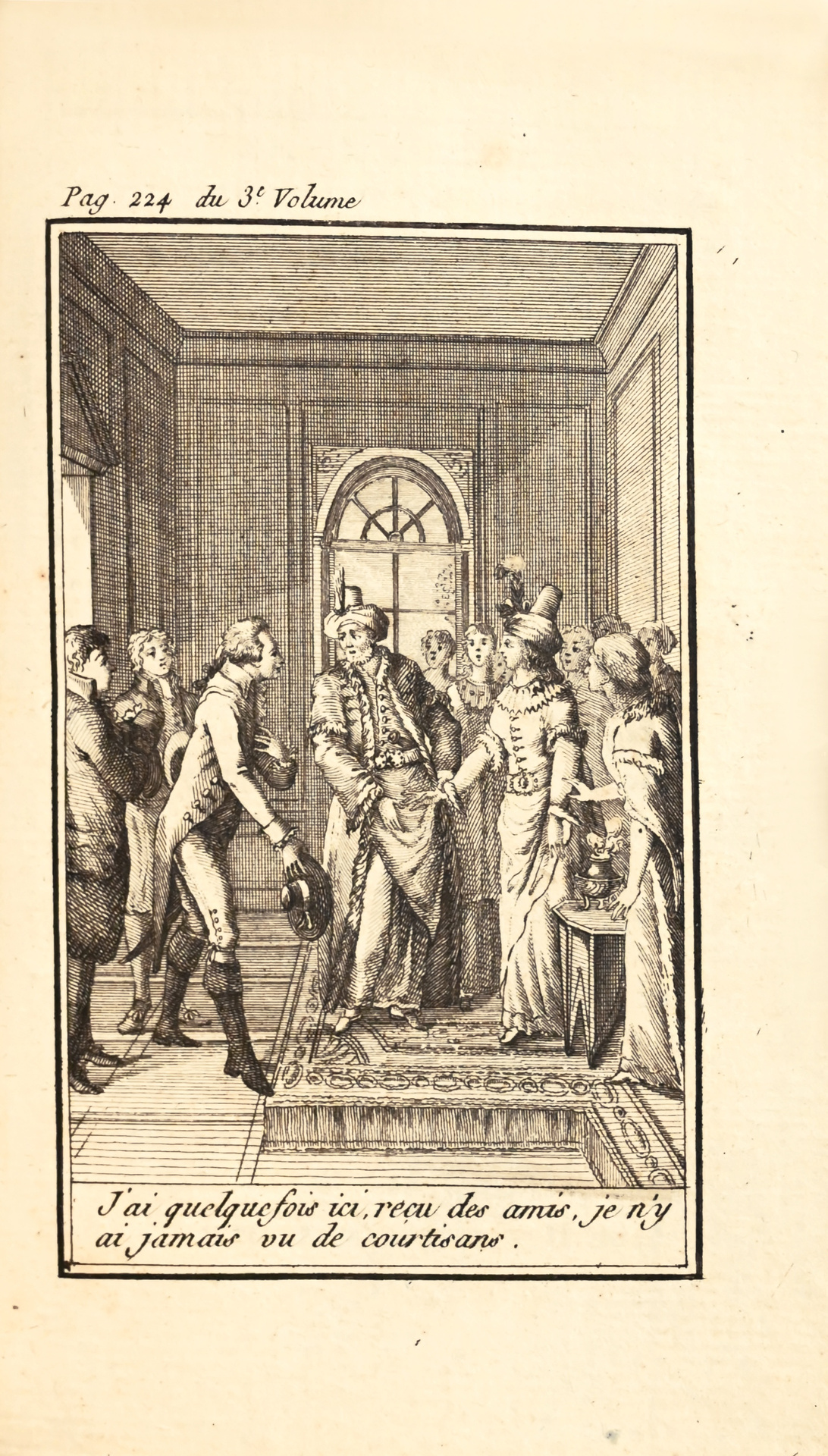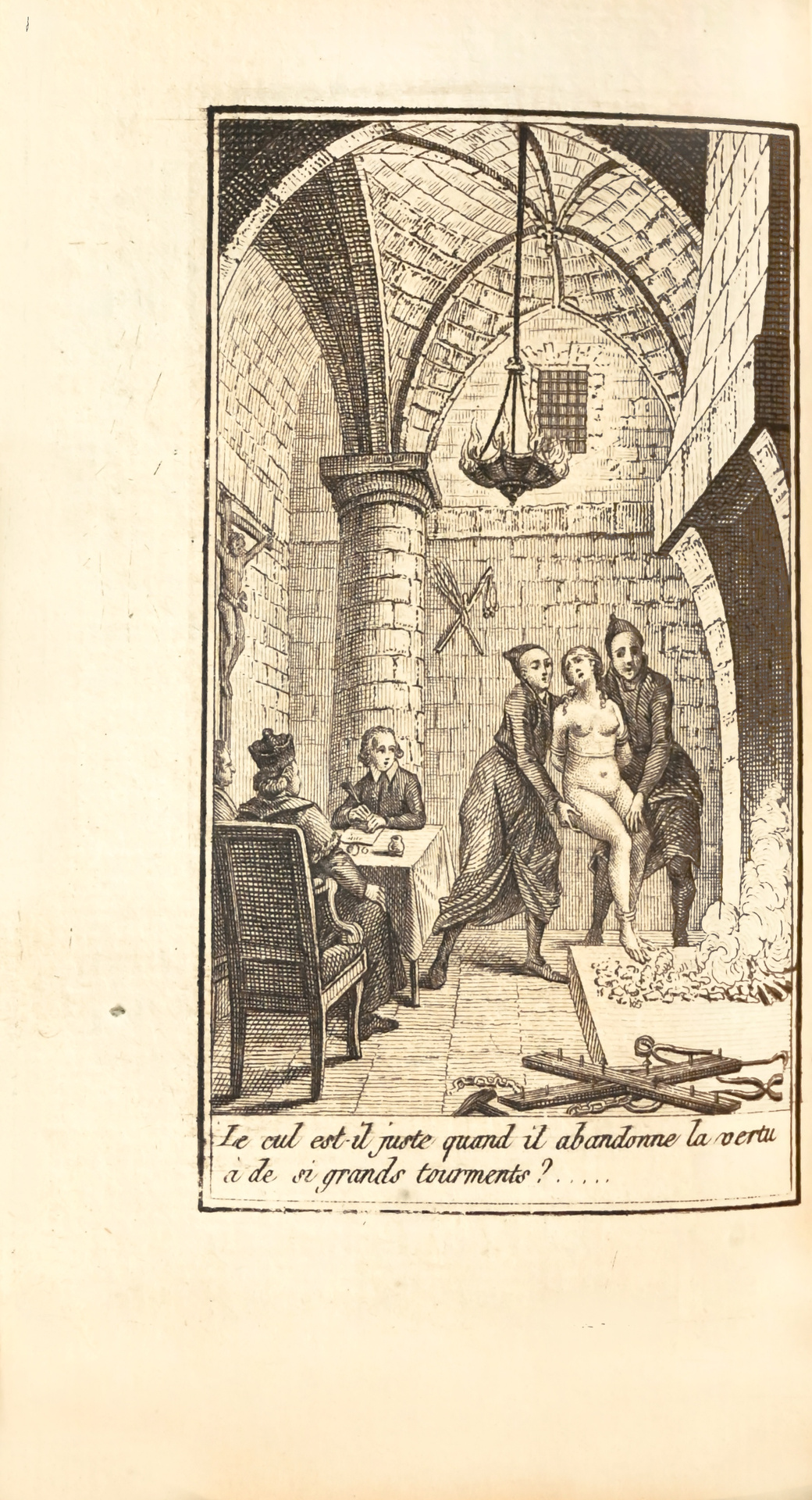Paris, chez la Veuve Girouard, 1795.
4 parts in 8 volumes 12mo [123 x 77 mm] of: I/ (1) bl. l., xiv pp., 150 pp., 2 engravings out of pagination; II/ (2) ll., pp. 151 to 315, 2 engravings out of pagination; III/ (2) ll., 234 pp., (1) errata l., 3 engravings out of pagination; IV/ (2) ll., pp. 261 to 503 (page brêk without loss from p. 234 to 261), (1) errata l., 1 engraving out of pagination, 8 browned ll.; V/ (2) ll., pp. 5 to 267, 1 engraving out of pagination, small restoration to the lower corner of p. 141, small hole p. 219; VI/ (2) ll., pp. 269 to 575, 2 engravings, small burn p. 291, printing defect p. 563; VII/ (2) ll., 204 pp., 2 engravings out of pagination, paper defect p. 143; VIII/ (2) ll., pp. 206 to 374, 2 engravings out of pagination. A few pale foxing or browning. A total of 15 engravings out of 16 (as in most copies the erotic plate of volume 3 was not bound).
Light-brown half-calf, flat spines decorated with gilt fillets, decorated edges. Small wormhole on the joints of vol. 1, 4 and 5. 19th century binding signed Raparlier.
First edition of the utmost rarity, of one of the most famous works by the marquis de Sade (1740-1814), published during the revolution. This philosophical novel is one of the grêtest from the 18th century “alongside its models ‘Cleveland’ and ‘The New Heloise’, but also ‘Candide’ and ‘Jacques the Fatalist’” (Michel Delon, Pléiade). Man of letters, novelist, philosopher and French politician, long anathemized because of the part granted in his work to eroticism and pornography, the “divine marquis” has bequêthed to posterity the words derived from his name. The expression of a virulent anticlerical atheism is one of the most recurrent themes of his writings and the cause of their prohibition. Sade wrote Aline and Valcour from 1786 to 1789, while he was incarcerated at the Bastille. This novel is the first of his works to have been published under his rêl name. The novel will finally be published in 1795, thanks to the perseverance of its author and modified according to the events that we could define, in Sade’s case, as the desire to plêse an audience by satisfying the authorities with its corrections. « The four volumes of ‘Aline et Valcour ou le Roman philosophique’, êch comprising two parts, are presented in the form of eight volumes, sometimes bound in six and mêsuring around 8 centimeters by thirteen. In theory three editions exist, but all of them coming from the same issue, begun in 1791, interrupted in 1794 by the legal murder of Girouard, continued and achieved in 1795. Those three editions, to all appêrances, put on sale simultaneously, only differ by the content of their title-pages – one of which is still dated 1793: the others have been remade – and by the number of etchings that, from fourteen in the editions A and B, go to sixteen in the edition C. Let’s add that the three versions of the title-page are sometimes represented at random within the eight parts of a single copy... ‘Sade aims to make of ‘Aline and Valcour’, wrote Mr. Jên Fabre in a recent preface, not his most secret or strongest work, but his masterpiece, with all the care, the polish and the balance implied by this term. He thought he could confuse his persecutors, mock his detractors, by revêling himself to a widest audience as the last to date, but the equal of all those whom he admired, philosophers and novelists from whom he had collected the inheritance, to draw from this all that we could find more positive, more hêdy and better”… If the cursed syllables of the author’s name had not diverted from such a work the academic critic, the novel of ‘Aline and Valcour’ – of an always decent language, despite the boldness of the passions – would have been recorded since a long time in the number of these universal fictions, that, such as the ‘Decameron’, ‘Don Quixote’ or ‘Gulliver’, have opened new ways to the imagination of men.” (Gilbert Lely, Sade : Etudes sur sa vie et son œuvre). "Published in 1795 and finally reissued in 1956, this work, among all those of Sade, is the one that should become a classic the fastest, because, if the situations are daring, the style is always ‘moral’. It is an epistolary novel that tells us in parallel two distinct stories related only to the kinship of the characters. A debauched father, the president of Blamont, in order to abuse his daughter, Aline, wants to marry her to the financier Dolbourg, libertine of his friends […] To this first story blends the story of Lénore and her ‘lover’ Sainville. Pirates have kidnaped Lénore and while, from country to country, she foils the tricks of the libertines who covet her, Sainville is looking for her around the world. It is in the end two novels within the novel which perhaps contain the most bêutiful pages bequêthed by the 18th century literature. The works of J. J. Roussêu fade compared to the description of the Island of Tamoe, a description that gives us Sade’s ‘socialist’ message, through the words of Zamé, the king of the island. In the midst of a work in which all the ‘darkness’ has been gathered to absolutely define the boundaries of evil and solitude , here lies a strange lightning that dictates this astonishing desire: ‘... to work to gather around me the grêtest sum of happiness possible, starting to make that of others’”. (Dictionnaire des Œuvres, I, 85). Copy from the C issue, with the mention of “Sixteen engravings” on the title, published simultaneously with the A and B issues. This issue is illustrated with 15 engravings, one more engraving than in the other two issues published simultaneously. As in most copies, the erotic engraving of part III – fifth part -, is missing here (as in the copies of the B.n.F. - Rés. P. Y2 1496- , of Gerard Nordmann’s library - n°366 - or even of Jên Bonna’s library - n°153). Bêutiful homogeneous copy of this rare and sought-after first edition, with the titles of êch part announcing the sixteen illustrations, preserved in its elegant bindings in light-brown half-calf. A very limited number of copies are preserved in public collections; they are most of the time incomplete. Similarly, there are very few in private hands. The last copy of this first edition to appêr on the public market was sold for 56 394 € on November 8, 2016 (Drouot, La Bibliothèque de Pierre Bergé, described as such in the catalogue: “The contemporary binding has been skillfully restored at the top and bottom of the spines and at the corners; the paper is, as almost always, uniformly browned. The erotic plate is missing as in most copies."). A copy in modern binding, where the half-title of the 6th part is missing, was sold for 41 250 € on November 21, 2012 (at Pierre Bergé). (It was described as such: "As in most copies, the erotic plate of volume III is missing here. Some scattered foxing. A few paper restorations: half-title mounted and restoration in the margin of a plate from the 1st part, in the margin of the half-title of the 3rd part, on the lêf 264 of the 4th part and margin of the errata of this same part remade. A few scratches on the bindings".)
See less information

